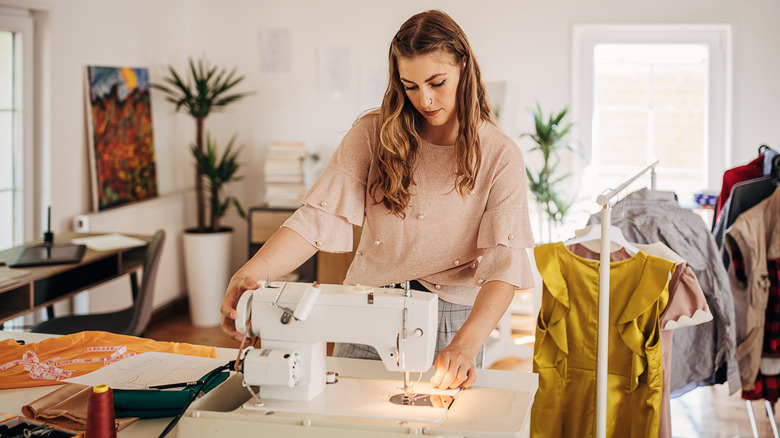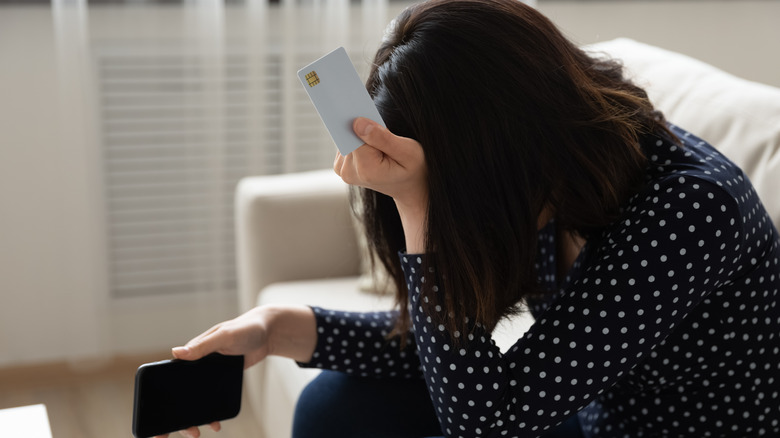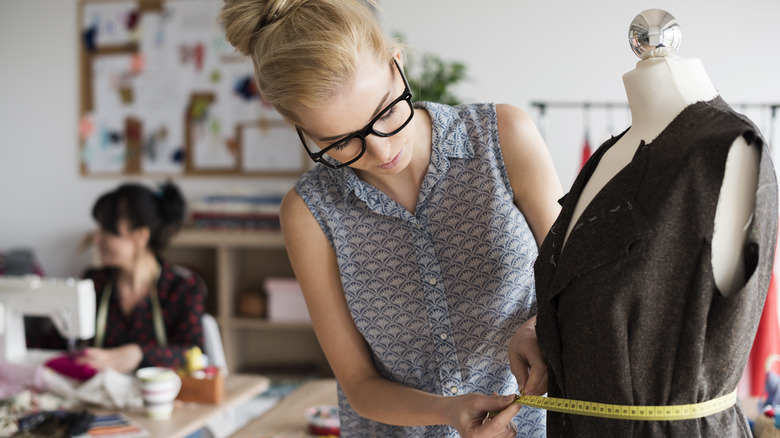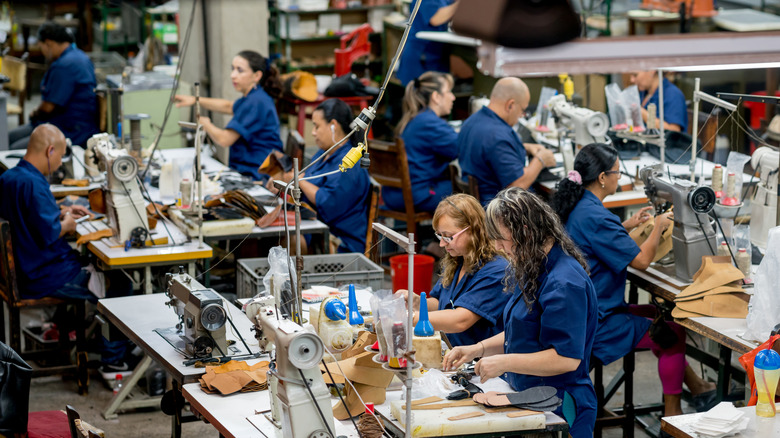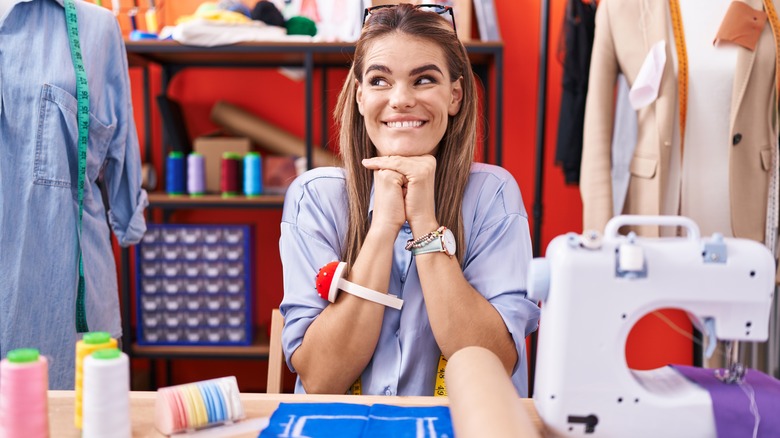Why Learning To Sew Your Own Clothes Is So Beneficial To Your Wardrobe And Bank Account
Perhaps people are getting sick of their screens and want to do something more hands-on with their spare time. Whatever the case, hobbies that once seemed old-fashioned are now ultra-trendy. Call it cottagecore, if you must, but pastimes like crocheting, gardening, baking from scratch, and so on are surging in popularity. All that said, it's none too shocking that people seem suddenly interested in one of the oldest skills known to humanity — sewing.
There are a lot of types of sewing (embroidery, cross-stitch, quilting, etc). In particular, clothes-making is starting to pique a lot of interest. This could be due to the ever-rising costs of wearable goods (thanks a lot, inflation), or just a simple desire to create something unique. Whatever the case, getting started sewing clothes isn't nearly as difficult as most people think. Plus, it'll make you feel metaphorically warm and fuzzy inside while keeping you literally warm and fuzzy on the outside.
It's cheaper than buying clothes
Everything is more expensive these days, thanks to historic inflation, which has amped up everyone's utility and food bills and left wiggle room for little else. Although clothing prices aren't as obscene as they were in 2022, according to financial data company YCharts, the August 2023 inflation rate for shoes and clothing was at 2.90%, which was far higher than the long-term average of 0.08%.
By comparison, sewing is far cheaper as long as you don't splurge on luxury fabrics. Clothing patterns can be bought online or in craft stores for only a few dollars per pattern. Then, they can be reused to create different versions of the same garment. Other than that expense, there's the initial cost of a basic sewing machine to consider, which can be affordably purchased on Amazon for around $100 — sometimes even less than that for miniature models. Over time, it will pay itself off in cost savings compared with retail shopping. The machine, plus some fabric, thread, and any embellishments you require for the piece (buttons, zippers, etc.), are all pennies on the dollar compared with mid-to-high-end clothing.
Some thrifty sewers make it even more cost-effective by reusing pieces they already have to generate a brand-new garment. You can also hit the local thrift shop and look less at the style and more at the fabric and its inherent potential. Think of it as the purest form of upcycling.
Clothes can be literally tailor-made
Sewing is one of the OG ways to express complete and total individuality. After all, the seamstress gets to hand-pick the fabric and pattern to suit her style and can sew it to fit her specifications exactly. For people with wide shoulders, those who need a little extra room in the chest, or just some other physical feature not typically valued by commercial designers, this is a huge benefit. Plus, turning out a one-of-a-kind piece also makes it far from likely that anyone else will show up wearing the same outfit.
The problem is that a lot of people don't know where to get started with learning how to sew clothes. Luckily, many craft stores offer classes to get a newbie going (check your local stores for details about in-person class options). You can also find a local independent sewing teacher to show you all the steps, from learning to thread the machine to creating a professional-looking dress hem. Many sewing and craft retailers have also entered the digital age. For example, JOANN Fabrics offers a selection of digital sewing courses on its site. Then, there's always YouTube, which has no shortage of sewing tutorials like one by Jusuf or another by Evelyn Wood. Watch a few videos, find a teacher who's easy to follow, and you'll be churning out garments in no time.
Sewing at home is non-controversial
Some people are steering away from fast-fashion brands in an effort to avoid products produced by unscrupulous or non-transparent companies. For example, Shein, the world's most popular such company (per Time), has repeatedly been accused of egregious human rights violations. These include unsafe working conditions, inhumane schedules, and any number of other labor law violations. Others wish to steer clear of companies that potentially test on animals and/or use animal materials in their products. Huge names top that list, according to Good On You, including Louis Vuitton, Fendi, Oscar de la Renta, among many others.
Then, there's the whole environmental sustainability angle to consider. For example, H&M recycles its clothing, but only 35%, per Sustainably Chic. Although it has gotten rid of some chemicals involved in the manufacturing process, it still produces far too much in the way of greenhouse gas emissions. In addition, lingerie powerhouse Victoria's Secret uses materials in its products that are not considered sustainable.
The fact is, sewing your own clothes allows for a lot of control over these issues. Plus, people who make something themselves are more likely to treasure the piece rather than contribute to a wasteful throwaway culture.
It's always good to learn something new
Too many people assume that they'll be bad at a skill like sewing because they don't know how to do it. However, most people are not inherently good at very many things — you had to learn to read and write once upon a time, didn't you? The fact is that learning a new skill is beneficial to the human mind and body in many ways. First, learning to sew your own clothes can keep you from being too idle, which can help to prevent loneliness, anxiety, depression, and so on. Keeping those hands busy can also keep you from reaching back out to that toxic ex-friend or significant other, too.
It's also always good for the brain to learn a new skill. "As you take on a new skill, the mind begins to reshape itself because the physical brain is malleable," life and wellness coach Dennis Buttimer told Piedmont Healthcare. "Previously, it was thought that it was only malleable until adolescence. However, now the research shows it can keep changing throughout our lives and for the better, so you have fewer fear responses and a more positive mindset." As you make gradual strides in learning how to make clothes, your confidence will increase, leading to improved self-esteem.
